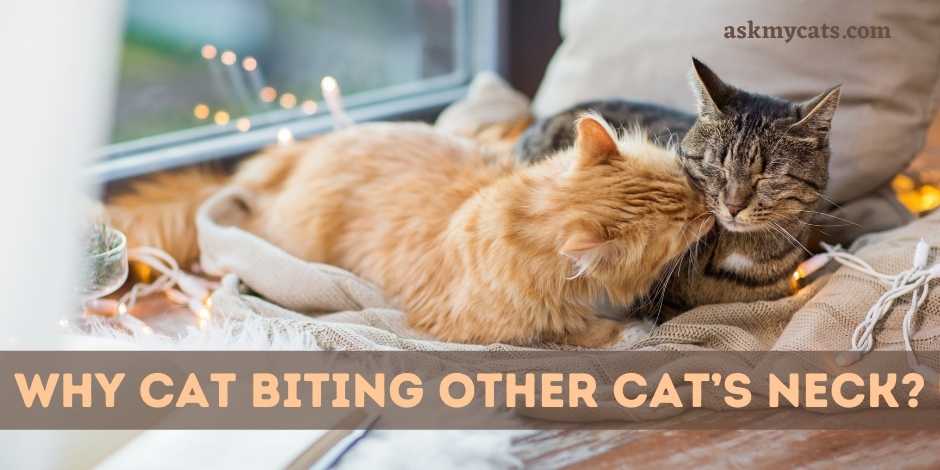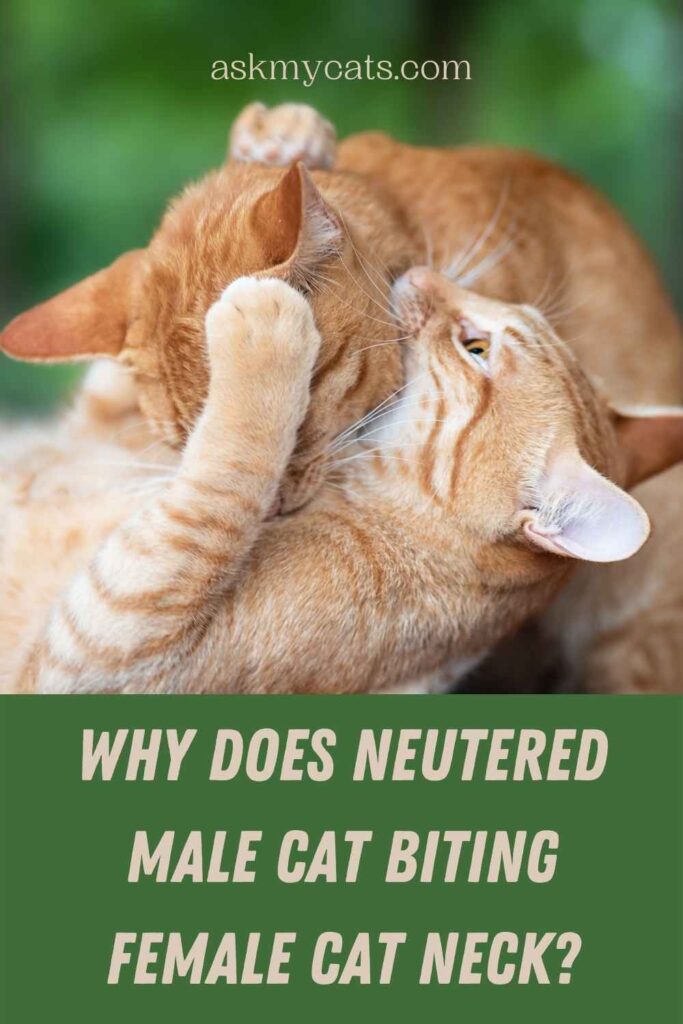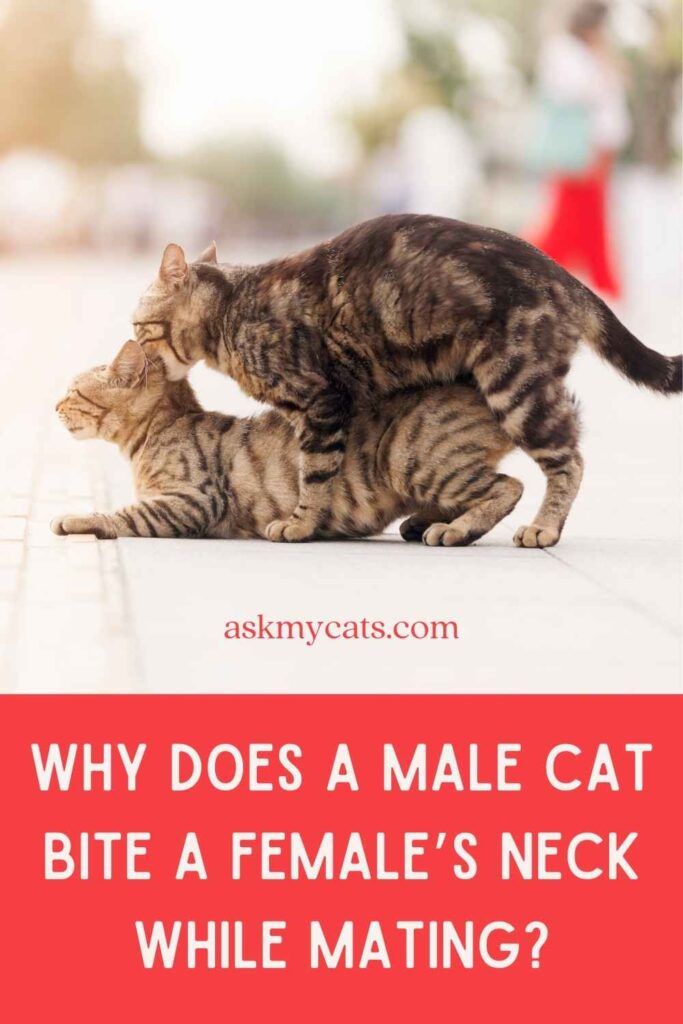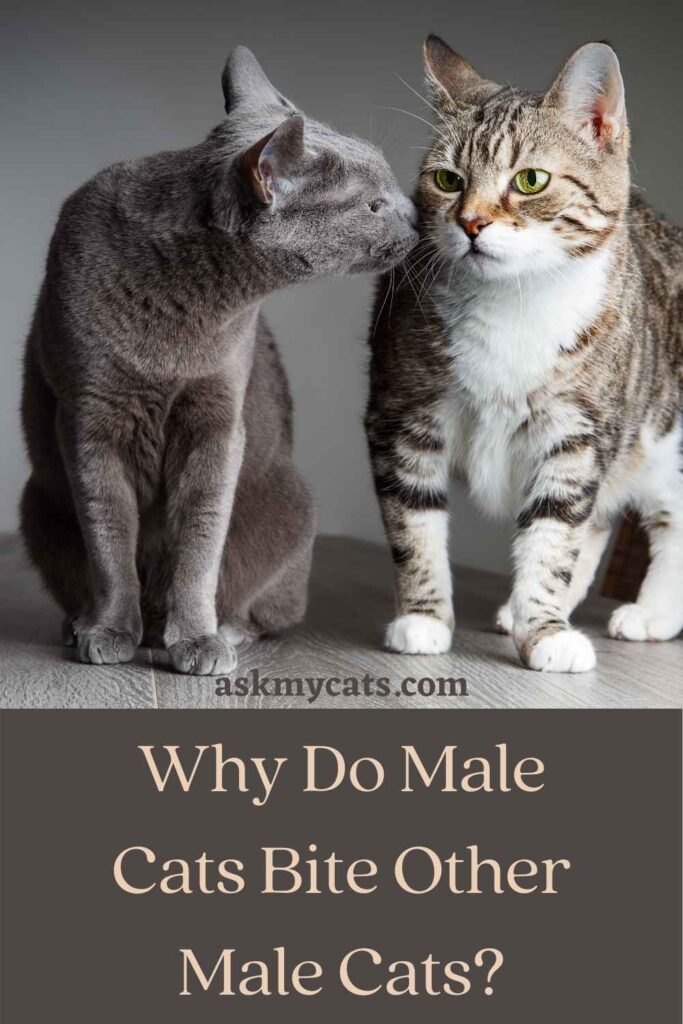Cat bites other cat’s neck because it makes him the ‘top cat’ in the house and not letting her forget it is a sign of superiority.
From the pose and attitudes of the cat, it can be acknowledged that are similar to that of a breeder. This may be a source of gratification or a source of superiority.
Any cats will do so just because they like it and would do the same to other cats, stuffed toys, puppies, and other animals.
If the other cat isn’t bothered by it, it’s really not worth thinking about. Ensure that the cat that is engaging in this activity has plenty of playtime, games, and stimuli. This could be beneficial.


Give Your Cat the Perfect Day
Get the Free Ebook!
Why Is My Cat Biting My Other Cats Neck?
It is a breeding behavior if no cat has been fixed (spayed or neutered).
It may be breeding behavior if the male is still alive. Cats mate by biting the girl and holding her down. If a female has not been spayed, this form of behavior on the tomcat may cause her to go into heat.
It is a type of domination behavior whether all cats are spayed or neutered. Consult the veterinarian with possible remedies.
They are taught how to diagnose what is behind the behavior, rule out medical issues, and provide advice about how to avoid it without medical intervention.
It’s mating behavior in its purest form. However, as others have pointed out, it can also be construed as a means of domination.
My male cat does this to my younger female cat on occasion, despite the fact that all cats are fixed and have been for a long time.
Her reaction to it is also amusing. She also lets him get away with it for a few minutes before he or she gets bored (if she gets bored, she just wriggles away from him because she’s much smaller and more agile than he is because he doesn’t bite hard).
But there are moments when she isn’t having it and twists around and swats at him before he even arrives. So it doesn’t matter if one of them is attempting to assert superiority over the other.
So just because one of them is attempting to assert superiority over the other does not mean it will be effective. This has been going on for years, so I guess they’ve found their own social equilibrium.
I’d make sure all cats are fixed, particularly because your male is biting your female so hard.
You should usually let them sort it out on their own after that as long as he doesn’t hurt her, so if he’s drawing blood or her responses get aggressive, you should certainly contact the vet.
Everyone seems to be pointing out the apparent “mating/dominance” relationship, but regular productive play sessions, ideally just after you get up in the morning and just before you go to bed, will lessen or remove all dominance activity.
For better performance, follow Jackson Galaxy’s play-eat-sleep strategy. Attaching a crinkle ball to a long wand and stringing it is a good idea (fishing pole).
Receipt tape should be used to create a crinkle ball – accordion To make a toy that can make the cat race 8–12 feet at one pounce without you having to step, fold a long piece of tape and tie it securely in the center, then trim it into the form of a ball, then tie the string to a 3-foot stick using 3-foot twine, fishing line, or heavy-duty cord.
Encourage him to pounce on a treat rather than the other cats if he tries to pounce. A bigger plastic ball with a bell inside and decorative pompoms and ribbons glued to it is another toy that requires more work.
I’ll have to keep a close eye on this one because I’m afraid the ribbons or pompoms will come off and cause a choking hazard. I’ve been effectively using this toy on an intact male who isn’t mine to save him from freaking out my fixed girl.
You will also like to read about why is my cat biting her kittens
Why Does Neutered Male Cat Biting Female Cat Neck?
Neutered male cat biting female cat neck because it’s a demonstration of strength. This is how cats really mate. She yowls that the male organ is spiked and hurts like hell as he takes it out, and the male bites her on the back of the neck to keep her in place.

Check with the veterinarian to see if anyone’s equipment was not entirely removed. You may also consider using a hormone infuser, which emits a hormone that is meant to stimulate them.
Sexual desires and actions do not go anywhere simply because the cats have been spayed or neutered.
Get your pet spayed or neutered by a veterinarian. This will put an end to the conduct, and both cats will be much happier.
The chewing on the neck is a part of the mating process, and it will continue before you do so. If the female has been neutered, she is the male’s source of annoyance.
If she doesn’t, she’ll almost certainly have kittens that will all need homes.
Many animals end up wandering the sidewalks, uncared for, or have to be slaughtered in rescue centers because there aren’t enough decent homes left.
Spaying the pets is much more humane than allowing this to happen.
This seems to be pure mate-seeking activity. I’m not sure about the ages/size differences/seniority in-home arrangement, but spaying/neutering completely eliminates or significantly reduces this behavior.
If this happens and the female does not defend herself, it could be a mode of play or a safety issue.
Distinguish them. Females should be spayed, and males should be neutered. After that, gradually reintroduce them to each other to see how he reacts. If he continues to do this, get the assistance of a feline or medical behavioral expert.
You might also like to read reasons about male cat attacking spayed female
Why Does a Male Cat Bite a Female’s Neck While Mating?
A male cat usually bites a female cat’s neck while mating to express their sexual attraction and behavior.

Many people are alarmed by this behavior (along with female cats’ shrieks) because it seems to be a coerced encounter, but neck biting is simply a protective activity on the part of the male.
Since females choose their partners and mating is voluntary, the male must defend himself in the event that she chooses to target him when he is in a vulnerable position.
When kept by the scruff of the neck, kittens have an instinct to keep still, and adult cats retain this instinct to some extent, so retaining the scruff of the neck decreases the risk of attack.
The spines on a male cat’s penis (which stimulate ovulation in female cats) were once thought to inflict discomfort during withdrawal when female cat shrieks after mating, but researchers now claim the shriek is an alarming gesture.
The girl, who is in a precarious situation due to the male’s teeth clamped on the back of her throat, warns him not to take advantage by acting aggressively.
Given that mating cats always don’t meet each other before mating, it’s prudent to take a few steps in case they’ve selected an especially unpredictable mate.
Actually, because cats are stimulated ovulators, I hypothesized that the neck bite might trigger some sort of stimulation of the pineal gland and/or hypothalamus, affecting egg release and/or lowering the female’s excessive estrogen levels to a manageable amount.
This behavior is also seen in induced ovulators like ferrets and minks, but not in dogs.
The pineal gland is involved because, as far as I’m aware, melatonin has a regulatory impact on the heat cycles of induced ovulators–this has been shown especially well in members of the weasel family, and it’s possible that it even plays a role in the heat cycles of cats.
Why Do Male Cats Bite Other Male Cats?
Male cats are seen biting other male cats because cats are aggressive animals that can fight tooth and nail to protect their territory.
Even cats that have gotten along in the past can start rubbing each other the wrong way now and then.
However, you will assist them in resuming their partnership.

Many people get a second cat in the hopes that the resident cat will like the company. This is a dangerous pass.
Your cat may be friendly and caring with you, but that doesn’t mean they’ll be sweet to another cat. It’s not unusual for the arrival of a new pet to the family to spark any conflict when the cat is territorial.
While proper introductions will raise the likelihood that they will get along or at least tolerate one another, there is no way to determine whether cats will get along.
Unfortunately, no teaching system will ensure that they can ever do so. Even if the cats don’t become best friends, you will normally reach an agreement.
When taking a new cat into the household, gently introduce the pets to avoid confrontation.
Male cats can threaten and fight with other male cats as adults. This is more likely with cats that have not been neutered. They can fight over a girl, a higher position in the pecking order, or protect territories.
To taunt each other, cats stalk, stare, yowl, howl, and puff up their fur (imagine the arched back of a Halloween cat). If one should stand down and walk away, the aggressor will normally walk away as well, having proven his case.
Cats will actually fight if no one backs down. They can bite, kick, slap, swat, or scream as they roll around, only to come to a halt, resume posturing, combat, or walk away.
Distract the cats by clapping enthusiastically, throwing a towel nearby, or squirting them with water if you see signs of a war brewing.
These acts can also be used to stop a war from escalating. Maintain a safe distance and never put your body parts in the middle of a fight; you could get hurt.
Cats will sometimes target their anger toward another animal or even a human who did not initiate the action if your cat is lying in the window and notices an outside cat walking through the front yard, for example.
When the cat is in his domain, they get irritated. You stroke them and they bite you. At that moment, your cat has no idea who you are because they are so agitated by the cat outside that they attack the first object that enters its way.
It’s critical to respond to this diverted hostility in a manner that protects both you and your agitated pet.
What To Do If Cat Bites Other Cats Neck While Grooming?
If a cat bites another cat’s neck while grooming, your first move should always be to call your veterinarian for a comprehensive health check if your pet has unexpectedly been more aggressive than normal.
Your angry cat could be sick and taking it out on others. Cats sometimes mask signs of sickness until they’re severely ill; your aggressive cat could be sick and taking it out on others.
If your pet receives a clean bill of health, seek advice from your veterinarian or an animal behavior expert. A behaviorist will help you figure out what you can do.
If the violence is serious and can’t be overcome, you will need to start the introduction process between two cats all over again, have the cats in different parts of your house, or maybe find one of the cats in a new home.
If you’re focusing on improving your cats’ habits, talk to your doctor for a short course of anti-anxiety treatment. Never offer your cat medication on your own.
Prevent future squabbles. This could mean holding the cats apart while you focus on the issue or at the very least avoiding interaction during scenarios that could lead to war.
Your cats should be spayed or neutered. Spaying and neutering cats will significantly minimize violence. One intact pet’s actions will have a detrimental impact on all of your pets.
Frequently Asked Questions
Why is my cat biting my other cat?
Fear, lack of socialization, improper arrival of a new cat, overcrowding (i.e. not enough vertical or horizontal space, too few resources, etc. ), diverted violence, play, and predation are some of the underlying non-medical causes of aggression between cats in the same household.
Are male cats still attracted to spayed female cats?
Many cat owners are concerned with sexual activity in their pets after a spay or neuter procedure. The short response is a big NO!
Final Words
Many things influence how well cats get along with one another, but even professionals in the field don’t completely comprehend them.
We do note that cats who have been well-socialized (those who have had positive encounters with other cats since kittenhood) are more sociable than those who haven’t.
“Street cats,” on the other hand, who are prone to battling with other cats to protect their turf and food, can struggle in a multi-cat household.
Drop your suggestions in the comments section below!
